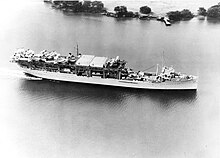USS Langley (CV-1)
|
||||||||||||||||||
|
||||||||||||||||||
|
||||||||||||||||||
|
||||||||||||||||||
The USS Langley (CV-1) was the United States Navy's first aircraft carrier . It had emerged in 1922 from a two-year conversion of the naval coal transporter USS Jupiter . In 1936 another conversion to a seaplane carrier took place .
On 27 February 1942, had to Langley on the way to Java after a Japanese air raid abandoned and of their own accompanying destroyers are sunk.
history
The ship was on 18 October 1911 the Mare Iceland Naval Shipyard in Kiel placed and ran on 14 August 1912 as USS Jupiter launched. It was the first ship in the US Navy to be powered by electric motors. Commissioned on April 7, 1913, the Jupiter was initially part of the Pacific Fleet . In October 1914, the ship moved to the Atlantic , where it was responsible for transporting coal and supplies during the First World War .
From 1920 on, the Norfolk Navy Yard converted the Jupiter into the first US aircraft carrier. The carrier was put into service on March 20, 1922. The ship was renamed Langley in honor of the American astronomer and physicist Samuel Pierpont Langley . Because of their almost rectangular side view, due to their construction as a flush deck carrier that got Langley nicknamed "Covered Wagon" (Eng .: at the sailors covered wagon ).
On October 17, 1922, Lieutenant Virgil C. Griffin made the first take-off from the deck of a US aircraft carrier with a Vought VE-7 . In October and November 1922, Langley 's first aircraft flew to the Caribbean for test operations . Then the ship was moved to the Pacific . In 1924, under the leadership of Captain Joseph M. Reeves , the naval pilots successfully developed take-off and landing techniques and tactical deployment profiles.
In the late 1920s, the US Navy put ever larger and faster aircraft carriers into service. The Langley remained in service as an aircraft carrier until 1936. Then it was converted into a tender for seaplanes at the Mare Island Navy Yard . Their new classification number was AV-3. The ship's well-trained pilots were transferred to the carriers USS Lexington and USS Saratoga .
The conversion to a seaplane carrier was carried out with the aim of allowing the USA to build the much more modern USS Wasp without exceeding the number of aircraft carriers contractually agreed in the Washington Fleet Agreement . As a result of the conversion, the ship could be used as a transporter for sea and land planes, as well as a seaplane tender . The conversion was completed on February 26, 1937 and in early April the Langley was assigned to the Aircraft Scouting Force . She was then deployed from Seattle , Sitka , Pearl Harbor, and San Diego . After a brief use in the Atlantic in 1939, she was anchored off Cavite in the Philippines as a tender for the Pacific Fleet at the beginning of the Pacific War .
After several transport missions to Balikpapan , Borneo and Darwin in December 1941, the Langley supported the Australian Air Force in mid-January 1942 with submarine search patrols off Darwin.
Sinking
On February 22, 1942, the Langley sailed from the Australian port of Fremantle to sail to Tjilatjap on Java on behalf of ABDACOM and reinforce the allied units there with 32 Curtiss P-40 aircraft. Shortly before the target, however, she was badly hit five times by the third wave of attacks during a Japanese air raid on February 27. This killed 16 crew members. The Langley then had to be abandoned by the crew and was then sunk by the destroyer companions USS Whipple and USS Edsall .
See also
- List of US Navy aircraft carriers
- List of US Navy aircraft carrier classes
- List of historical aircraft carriers
- List of ship types
Web links
- USS Langley (US Navy) (English)
- NavSource Online (English)




